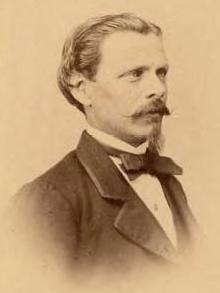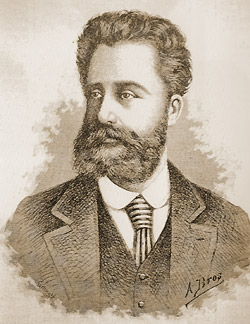
Zarzuela is a Spanish lyric-dramatic genre that alternates between spoken and sung scenes, the latter incorporating operatic and popular songs, as well as dance. The etymology of the name is uncertain, but some propose it may derive from the name of a royal hunting lodge, the Palace of Zarzuela, near Madrid, where that type of entertainment was allegedly first presented to the court. The palace in turn was named after the brambles that grew there.

Comic opera, sometimes known as light opera, is a sung dramatic work of a light or comic nature, usually with a happy ending and often including spoken dialogue.
Género chico is a Spanish genre of short, light plays with music. It is a major branch of zarzuela, Spain's form of popular music theatre with dialogue, and differs from zarzuela grande and most other operatic forms both in its brevity and by being aimed at audiences of a wide social spectrum.

The Teatro Real is an opera house in Madrid, Spain. Located at the Plaza de Oriente, opposite the Royal Palace, and known colloquially as El Real, it is considered the top institution of the performing and musical arts in the country and one of the most prestigious opera houses in Europe.

Tomás Bretón y Hernández was a Spanish conductor and composer.

The Orquesta Sinfónica de Madrid, founded in 1903, is a Spanish symphony orchestra. Since 1998, is the principal orchestra of the Teatro Real.

Gerónimo Giménez y Bellido was a Spanish conductor and composer, who dedicated his career to writing zarzuelas, such as La tempranica and La boda de Luis Alonso. He preferred to spell his first name with a "G", even though his name at birth officially began with a "J".
Francisco Kraus Trujillo was a Spanish baritone.
Spanish opera is both the art of opera in Spain and opera in the Spanish language. Opera has existed in Spain since the mid-17th century.

The Auditorio Nacional de Música is a complex of concert venues located in Madrid, Spain and the main concert hall in the Madrid metropolitan area. It comprises two main concert rooms: a symphonic hall and a chamber music hall.

The Teatro de la Maestranza is an opera house located in Seville, Spain.

Salvador Videgain García was a Spanish author and theatrical actor, director and producer. He was known for performing comedic and zarzuela roles in Spain and the Américas during the first half of the 20th century. He was born in Madrid, where he also died. He was the son of singers and actors Salvador Videgain Gómez and Antonia García.

María Rodrigo was a Spanish pianist and composer. She was the daughter of Pantaléon Rodrigo, and studied music at the Madrid Conservatorium under José Tragó for piano, Valentín Arín for harmony and Emilio Serrano for composition. Maria was the first woman to have her opera performed in Spain. Her sister Mercedes Rodrigo was equally intelligent, being the first woman from Spain to obtain a degree in psychology from the Rousseau Institute in Geneva. The two left Spain for Switzerland during the Spanish Civil War, moved in 1939 to Bogota, Colombia, at the invitation of rector Agustín Nieto Caballero, and in 1950 to Puerto Rico at the invitation of José María García Madrid. With Pablo Casals, Rodrigo founded the Puerto Rico Conservatory of Music. She died in Puerto Rico in 1967. Maria was one of the few composers that addressed the composition of zarzuelas, a genre of Spanish music.

Francisco Alonso López was a Spanish composer of popular theatre music and zarzuelas.

Jerónimo de la Gándara (1825–1877) was a Spanish architect who designed a number of public buildings during the reign of Isabella II of Spain.

CristóbalOudrid y Segura was a Spanish pianist, conductor, and composer. He is noted for his many contributions to the formation and development of the zarzuela genre in Spain during the second half of the 19th century. He was a gifted musician—but with little technical knowledge, which he bragged about to receive more credit from others with relation to his creations. This habit earned him the scathing criticism of people like Antonio Peña y Goñi who, nevertheless, praised the bright, sensual and cheerful ease with which Oudrid used to bring to life the true meaning of the Spanish song.

Joaquín Romualdo Gaztambide y Garbayo was one of the most prominent Spanish composers of zarzuela in the mid-nineteenth century. His contribution to the revival of the genre was highly significant; and although during the last century his work virtually disappeared from the Spanish musical scene, the early 21st century has reversed this trend. Of Italianate quality in the manner of Gaetano Donizetti, his music nonetheless makes use of Spanish rhythms and dance forms. Among other renowned works, his La Mensajera (1849), El valle de Andorra (1851), El sueño de una noche de verano, Catalina (1854), Los magiares (1857), El juramento (1858), and the one-act classic Una vieja (1860) stand out.

Josefa Embil Echániz better known as Pepita Embil was a Spanish Basque soprano who starred in zarzuela and operetta productions throughout Spain and Latin America. Known as the "Queen of Zarzuela," she is especially remembered for her son, the internationally famous operatic tenor Plácido Domingo, whose early career she helped to nurture. Embil began her professional career singing as a soloist in choirs, including the Basque national choir, Eresoinka, which based itself in France during the Spanish Civil War. While still in her twenties, she appeared in the world premieres of several new zarzuelas. She collaborated with some of the most prominent Spanish composers of the 1940s, including Federico Moreno Torroba, Jacinto Guerrero, and Pablo Sorozábal. In late 1948, she moved to Mexico with her baritone husband, Plácido Domingo Ferrer. In Mexico they ran a successful zarzuela company of their own, which toured throughout the Americas. Over the course of her career, Embil made several recordings, primarily of zarzuela music.

Francisco Lleroa y Salas was a Spanish classical opera singer (bass-baritone), one of the crucial figures in the revival of the zarzuela genre.

The Teatro Principal de València, meaning Main Theatre of València, is a theatre in Valencia, Spain. It is located in downtown Carrer de les Barques, close from the City Hall, as well as the Northern Station and the adjacent Bullring.

















